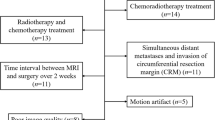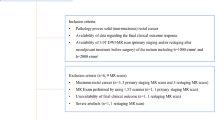Abstract
Purpose
To investigate the usefulness of b value threshold (bThreshold) map in the evaluation of rectal adenocarcinoma by comparing it with diffusion-weighted images and ADC maps regarding lesion detection and the prediction of pathological features.
Materials and Methods
Thirty-five patients with rectal tumors were enrolled and underwent axial DWI using a 3-Tesla MRI system. Contrast-to-noise ratio (CNR) between the lesions and normal tissues were assessed on the diffusion-weighted images and bThreshold maps. Reproducibility for ADC and bThreshold values were assessed. Significant differences between different groups for pathological prognostic factors were evaluated. Diagnostic performance of ADC and bThreshold values for those factors were assessed.
Results
Reproducibility was excellent for the ADC and bThreshold values (ICC 0.985 and 0.992; CV 3.8% and 4.0%) measurements. The CNR between lesions and normal tissues on bThreshold maps was significantly higher than that on diffusion-weighted images (9.91 ± 5.35 vs. 7.68 ± 3.08, p = 0.012). There were significant differences in the ADC and bThreshold values between different pathologic differentiation degrees and T stages; significant difference was observed in the bThreshold values between the different N stage groups (all p values < 0.050). No significant differences were observed between the ROC curves of ADC and the bThreshold values of rectal lesions for pathologic differentiation and T stage. bThreshold maps showed good diagnostic performance for N stage.
Conclusion
Both ADC and bThreshold values can differentiate between degrees of pathologic differentiation and T1-2 versus T3-4. Potential added advantages however of the bThreshold map include a higher CNR compared with DWI images, thereby improving lesion visualization detection, and better diagnostic performance for end staging than ADC. Thus, the bThreshold map may compliment DWI and ADC to evaluate pathologic features of rectal primary tumors and metastatic lymph nodes.




Similar content being viewed by others
References
Bray F, Ferlay J, Soerjomataram I, Siegel RL, Torre LA, Jemal A (2018) Global cancer statistics 2018: GLOBOCAN estimates of incidence and mortality worldwide for 36 cancers in 185 countries. CA Cancer J Clin 68 (6):394-424. https://doi.org/10.3322/caac.21492
Pan R, Zhu M, Yu C, Lv J, Guo Y, Bian Z, Yang L, Chen Y, Hu Z, Chen Z, Li L, Shen H, China Kadoorie Biobank Collaborative G (2017) Cancer incidence and mortality: A cohort study in China, 2008-2013. Int J Cancer 141 (7):1315-1323. https://doi.org/10.1002/ijc.30825
Benson AB, Venook AP, Al-Hawary MM, Cederquist L, Chen Y-J, Ciombor KK, Cohen S, Cooper HS, Deming D, Engstrom PF, Grem JL, Grothey A, Hochster HS, Hoffe S, Hunt S, Kamel A, Kirilcuk N, Krishnamurthi S, Messersmith WA, Meyerhardt J, Mulcahy MF, Murphy JD, Nurkin S, Saltz L, Sharma S, Shibata D, Skibber JM, Sofocleous CT, Stoffel EM, Stotsky-Himelfarb E, Willett CG, Wuthrick E, Gregory KM, Gurski L, Freedman-Cass DA (2018) Rectal Cancer, Version 2.2018, NCCN Clinical Practice Guidelines in Oncology. Journal of the National Comprehensive Cancer Network 16 (7):874-901. https://doi.org/10.6004/jnccn.2018.0061
Lee YC, Hsieh CC, Chuang JP (2013) Prognostic significance of partial tumor regression after preoperative chemoradiotherapy for rectal cancer: a meta-analysis. Dis Colon Rectum 56(9):1093-1101. https://doi.org/10.1097/DCR.0b013e318298e36b
Lambregts DMJ, van Heeswijk MM, Delli Pizzi A, van Elderen SGC, Andrade L, Peters N, Kint PAM, Osinga-de Jong M, Bipat S, Ooms R, Lahaye MJ, Maas M, Beets GL, Bakers FCH, Beets-Tan RGH (2017) Diffusion-weighted MRI to assess response to chemoradiotherapy in rectal cancer: main interpretation pitfalls and their use for teaching. Eur Radiol 27 (10):4445-4454. https://doi.org/10.1007/s00330-017-4830-z
Bassaneze T, Goncalves JE, Faria JF, Palma RT, Waisberg J (2017) Quantitative Aspects of Diffusion-weighted Magnetic Resonance Imaging in Rectal Cancer Response to Neoadjuvant Therapy. Radiol Oncol 51 (3):270-276. https://doi.org/10.1515/raon-2017-0025
Iannicelli E, Di Pietropaolo M, Pilozzi E, Osti MF, Valentino M, Masoni L, Ferri M (2016) Value of diffusion-weighted MRI and apparent diffusion coefficient measurements for predicting the response of locally advanced rectal cancer to neoadjuvant chemoradiotherapy. Abdom Radiol (NY) 41 (10):1906-1917. https://doi.org/10.1007/s00261-016-0805-9
Koh DM, Collins DJ (2007) Diffusion-weighted MRI in the body: applications and challenges in oncology. AJR Am J Roentgenol 188 (6):1622-1635. https://doi.org/10.2214/AJR.06.1403
Sun Y, Tong T, Cai S, Bi R, Xin C, Gu Y (2014) Apparent Diffusion Coefficient (ADC) value: a potential imaging biomarker that reflects the biological features of rectal cancer. PLoS One 9 (10):e109371. https://doi.org/10.1371/journal.pone.0109371
Hausmann D, Liu J, Budjan J, Reichert M, Ong M, Meyer M, Smakic A, Grimm R, Strecker R, Schoenberg SO, Wang X, Attenberger UI (2018) Image Quality Assessment of 2D versus 3D T2WI and Evaluation of Ultra-high b-Value (b=2,000 mm/s(2)) DWI for Response Assessment in Rectal Cancer. Anticancer Res 38 (2):969-978. https://doi.org/10.21873/anticanres.12311
Delli Pizzi A, Caposiena D, Mastrodicasa D, Trebeschi S, Lambregts D, Rosa C, Cianci R, Seccia B, Sessa B, Di Flamminio FM, Chiacchiaretta P, Caravatta L, Cinalli S, Di Sebastiano P, Caulo M, Genovesi D, Beets-Tan R, Basilico R (2019) Tumor detectability and conspicuity comparison of standard b1000 and ultrahigh b2000 diffusion-weighted imaging in rectal cancer. Abdom Radiol (NY). https://doi.org/10.1007/s00261-019-02177-y
Porter DA, Heidemann RM (2009) High resolution diffusion-weighted imaging using readout-segmented echo-planar imaging, parallel imaging and a two-dimensional navigator-based reacquisition. Magn Reson Med 62 (2):468-475. https://doi.org/10.1002/mrm.22024
Feng Q, Yan YQ, Zhu J, Xu JR (2014) T staging of rectal cancer: accuracy of diffusion-weighted imaging compared with T2-weighted imaging on 3.0 tesla MRI. J Dig Dis 15 (4):188-194. https://doi.org/10.1111/1751-2980.12124
Heijnen LA, Lambregts DM, Mondal D, Martens MH, Riedl RG, Beets GL, Beets-Tan RG (2013) Diffusion-weighted MR imaging in primary rectal cancer staging demonstrates but does not characterise lymph nodes. Eur Radiol 23 (12):3354-3360. https://doi.org/10.1007/s00330-013-2952-5
Intven M, Reerink O, Philippens ME (2014) Repeatability of diffusion-weighted imaging in rectal cancer. J Magn Reson Imaging 40 (1):146-150. https://doi.org/10.1002/jmri.24337
Jung SH, Heo SH, Kim JW, Jeong YY, Shin SS, Soung MG, Kim HR, Kang HK (2012) Predicting response to neoadjuvant chemoradiation therapy in locally advanced rectal cancer: diffusion-weighted 3 Tesla MR imaging. J Magn Reson Imaging 35 (1):110-116. https://doi.org/10.1002/jmri.22749
Nougaret S, Reinhold C, Mikhael HW, Rouanet P, Bibeau F, Brown G (2013) The use of MR imaging in treatment planning for patients with rectal carcinoma: have you checked the "DISTANCE"? Radiology 268 (2):330-344. https://doi.org/10.1148/radiol.13121361
Pham TT, Liney G, Wong K, Rai R, Lee M, Moses D, Henderson C, Lin M, Shin JS, Barton MB (2017) Study protocol: multi-parametric magnetic resonance imaging for therapeutic response prediction in rectal cancer. BMC Cancer 17 (1):465. https://doi.org/10.1186/s12885-017-3449-4
Gall P, Kasibhatla R, Meyer H (2014) Improved lesion visualization using b-value maps based on thresholded DWI images. Paper presented at the ISMRM, #6639
Chen L, Shen F, Li Z, Lu H, Chen Y, Wang Z, Lu J (2018) Diffusion-weighted imaging of rectal cancer on repeatability and cancer characterization: an effect of b-value distribution study. Cancer Imaging 18(1):43. https://doi.org/10.1186/s40644-018-0177-1
Sun Y, Hu P, Wang J, Shen L, Xia F, Qing G, Hu W, Zhang Z, Xin C, Peng W, Tong T, Gu Y (2018) Radiomic features of pretreatment MRI could identify T stage in patients with rectal cancer: Preliminary findings. J Magn Reson Imaging. https://doi.org/10.1002/jmri.25969
Edge SB, Byrd DR, Compton CC, Fritz AG, Greene FL, Trotti A, editors (2010) AJCC cancer staging manual. 7th edn. Springer, New York, NY
Shrout PE, Fleiss JL (1979) Intraclass correlations: uses in assessing rater reliability. Psychol Bull 86(2):420–428. https://doi.org/10.1037//0033-2909.86.2.420
Akashi M, Nakahusa Y, Yakabe T, Egashira Y, Koga Y, Sumi K, Noshiro H, Irie H, Tokunaga O, Miyazaki K (2014) Assessment of aggressiveness of rectal cancer using 3-T MRI: correlation between the apparent diffusion coefficient as a potential imaging biomarker and histologic prognostic factors. Acta Radiol 55 (5):524-531. https://doi.org/10.1177/0284185113503154
Cho EY, Kim SH, Yoon JH, Lee Y, Lim YJ, Kim SJ, Baek HJ, Eun CK (2013) Apparent diffusion coefficient for discriminating metastatic from non-metastatic lymph nodes in primary rectal cancer. Eur J Radiol 82 (11):e662-668. https://doi.org/10.1016/j.ejrad.2013.08.007
Curvo-Semedo L, Lambregts DM, Maas M, Beets GL, Caseiro-Alves F, Beets-Tan RG (2012) Diffusion-weighted MRI in rectal cancer: apparent diffusion coefficient as a potential noninvasive marker of tumor aggressiveness. J Magn Reson Imaging 35 (6):1365-1371. https://doi.org/10.1002/jmri.23589
Al-Sukhni E, Milot L, Fruitman M, Beyene J, Victor JC, Schmocker S, Brown G, McLeod R, Kennedy E (2012) Diagnostic accuracy of MRI for assessment of T category, lymph node metastases, and circumferential resection margin involvement in patients with rectal cancer: a systematic review and meta-analysis. Ann Surg Oncol 19 (7):2212-2223. https://doi.org/10.1245/s10434-011-2210-5
Dewhurst C, Rosen MP, Blake MA, Baker ME, Cash BD, Fidler JL, Greene FL, Hindman NM, Jones B, Katz DS, Lalani T, Miller FH, Small WC, Sudakoff GS, Tulchinsky M, Yaghmai V, Yee J (2012) ACR Appropriateness Criteria pretreatment staging of colorectal cancer. J Am Coll Radiol 9 (11):775-781. https://doi.org/10.1016/j.jacr.2012.07.025
Tezcan D, Turkvatan A, Turkoglu MA, Bostanci EB, Sakaogulllari Z (2013) Preoperative staging of colorectal cancer: accuracy of single portal venous phase multidetector computed tomography. Clin Imaging 37 (6):1048-1053. https://doi.org/10.1016/j.clinimag.2013.08.003
Bipat S, Glas AS, Slors FJ, Zwinderman AH, Bossuyt PM, Stoker J (2004) Rectal cancer: local staging and assessment of lymph node involvement with endoluminal US, CT, and MR imaging--a meta-analysis. Radiology 232 (3):773-783. https://doi.org/10.1148/radiol.2323031368
Tang C, Lin MB, Xu JL, Zhang LH, Zuo XM, Zhang ZS, Liu MX, Xu JM (2018) Are ADC values of readout-segmented echo-planar diffusion-weighted imaging (RESOLVE) correlated with pathological prognostic factors in rectal adenocarcinoma? World J Surg Oncol 16 (1):138. https://doi.org/10.1186/s12957-018-1445-z
Acknowledgements
This work was supported by the National Key Clinical Specialist Construction Programs of China and the Youth Initiative Fund of Second Military Medical University (Grant No. 2018QN05).
Author information
Authors and Affiliations
Contributions
CF and XY are employees of Siemens Healthcare (Shenzhen and Shanghai, China, respectively). FS, LC, and JL who are not employees of Siemens Healthcare had control of the data and information submitted for publication.
Corresponding author
Ethics declarations
Conflict of interest
The authors declare that they have no conflict of interest.
Additional information
Publisher's Note
Springer Nature remains neutral with regard to jurisdictional claims in published maps and institutional affiliations.
Rights and permissions
About this article
Cite this article
Shen, F., Chen, L., Li, Z. et al. The usefulness of b value threshold map in the evaluation of rectal adenocarcinoma. Abdom Radiol 45, 332–341 (2020). https://doi.org/10.1007/s00261-019-02272-0
Published:
Issue Date:
DOI: https://doi.org/10.1007/s00261-019-02272-0




